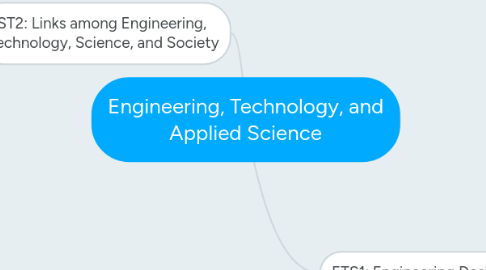
1. EST2: Links among Engineering, Technology, Science, and Society
1.1. ETS2.A: Interdependence of Science, Engineering, and Technology
1.1.1. Grade 2: engineering tools can be used in science
1.1.2. Grade 5: scientific discoveries of the natural world can lead to technology improvements
1.1.3. Grade 8: new science may need to be explored, and technology can expand scientific investigations (mutually supportive)
1.1.4. Grade 12: R&D cycle represents the complementary cycle between science and engineering
1.2. ETS2.B: Influence of Engineering, Technology, and Science on Society and the Natural World
1.2.1. Grade 2: developing and using technology impacts the natural world by applying science
1.2.2. Grade 5: engineering changes the way people live and interact
1.2.3. Grade 8: technology use may be limited by societal needs, findings of scientific research, climate, natural resources, and economics
1.2.4. Grade 12: engineering application depends on market forces, societal requirements, and governmental regulation due to the potential impact on society and the environment
2. ETS1: Engineering Design
2.1. ETS1.A: Defining and Delimiting an Engineering Problem
2.1.1. Grade 2: understand the problem being solved
2.1.2. Grade 5: understand constraints and criteria
2.1.3. Grade 8: successful design maps criteria and constraints to scientific principles
2.1.4. Grade 12: criteria and constraints affect durability, function, size, costs
2.2. ETS1.B: Developing Possible Solutions
2.2.1. Grade 2: convey (communicate) designs with sketches, drawings, models
2.2.2. Grade 5: research required, often collaborative (brainstorming), with testing
2.2.3. Grade 8: systematic processes guide testing for design evaluation
2.2.4. Grade 12: complex problems can be broken into components
2.3. ETS1.C: Optimizing the Design Solution
2.3.1. Grade 2: multiple solutions are possible
2.3.2. Grade 5: different solutions are tested to see which is best
2.3.3. Grade 8: systematic processes, often iterative, guide evaluation with respect to constraints and criteria
2.3.4. Grade 12: optimization often involves trade-offs
